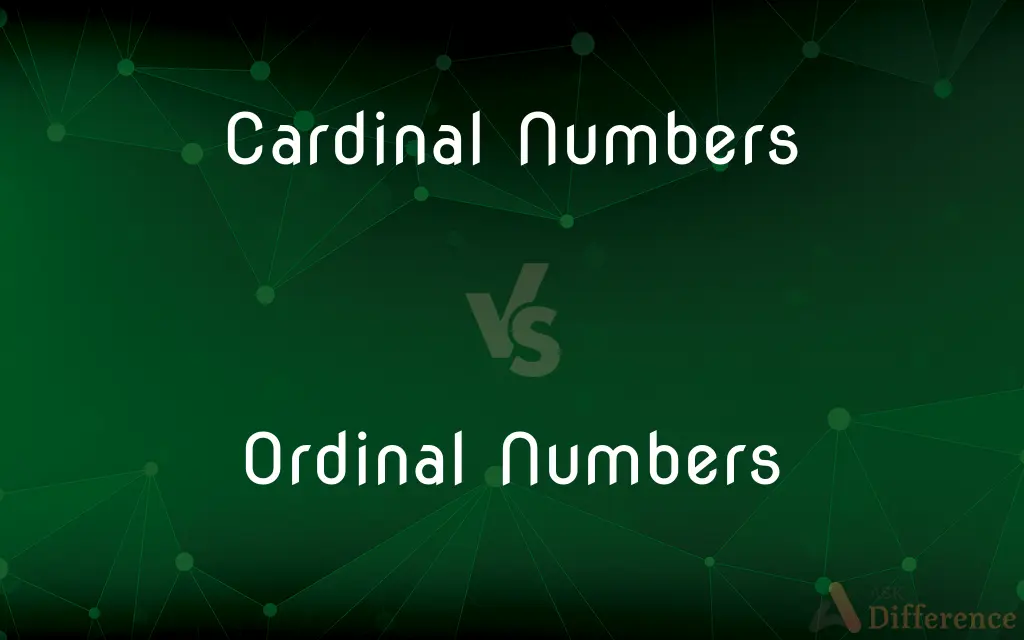Cardinal Numbers vs. Ordinal Numbers — What's the Difference?
By Tayyaba Rehman & Urooj Arif — Published on February 1, 2024
Cardinal numbers count quantity (1, 2, 3), while ordinal numbers show position or order (1st, 2nd, 3rd).

Difference Between Cardinal Numbers and Ordinal Numbers
Table of Contents
ADVERTISEMENT
Key Differences
Cardinal numbers represent quantities or amounts. They answer the question "How many?" For example, three books, five apples. Ordinal numbers, on the other hand, express position or rank in a sequential order, such as first in line, second place.
Cardinal numbers are used for counting and measurement. They are essential in daily life for quantifying objects or occurrences. Ordinal numbers are crucial when order or rank is important, like in competitions or listing steps in a process.
In mathematics, cardinal numbers are foundational for arithmetic operations such as addition and subtraction. Ordinal numbers are used to describe the nth term in a sequence, indicating a specific position within a set.
When referring to dates, cardinal numbers specify the number of days in a month, while ordinal numbers are used to denote the day's position within the month. For example, April 4 (cardinal) versus the 4th of April (ordinal).
In grammar, cardinal numbers can function as adjectives, pronouns, or nouns. Ordinal numbers typically serve as adjectives, modifying nouns to indicate their position or sequence in a list.
ADVERTISEMENT
Comparison Chart
Function
Count quantity
Show position or order
Example Usage
"I have two apples."
"She finished in first place."
Mathematical Operations
Used in arithmetic
Indicate sequence in sets
Grammar Role
Adjectives, pronouns, nouns
Primarily adjectives
Date References
Number of days (e.g., April 4)
Day's position (e.g., 4th of April)
Compare with Definitions
Cardinal Numbers
Represents the number of items in a set.
I have three dogs.
Ordinal Numbers
Establish a specific order within a set.
The third chapter of the book is the most interesting.
Cardinal Numbers
Used to specify quantity or amount.
There are seven continents.
Ordinal Numbers
Identify the rank or order among a group.
She was the second to present.
Cardinal Numbers
The numerical aspect of an object's quantity.
The jar contains twenty marbles.
Ordinal Numbers
Denote an item's position in a sequence.
He finished the race in third place.
Cardinal Numbers
Basic elements for arithmetic operations.
Four plus two equals six.
Ordinal Numbers
Order elements in a list or series.
January is the first month of the year.
Cardinal Numbers
Indicate how many objects or the size of a group.
She bought five apples.
Ordinal Numbers
Show the order of events or items.
Her birthday is on the 21st of the month.
Common Curiosities
Can cardinal numbers be used in arithmetic?
Yes, cardinal numbers are fundamental in arithmetic operations.
What are cardinal numbers?
Cardinal numbers denote quantity, such as one, two, three.
How are ordinal numbers used?
Ordinal numbers indicate position or order, like first, second, third.
Are there any cardinal numbers that cannot be used for counting?
Zero is a cardinal number often debated for its counting ability.
Are ordinal numbers ever used in mathematics outside of sequence?
Primarily, ordinal numbers are used to denote position within a sequence.
How do cardinal numbers function in grammar?
They can act as adjectives, pronouns, or nouns to indicate quantity.
How do ordinal numbers relate to dates?
They indicate the day's position within a month or year.
How do cardinal numbers relate to measurements?
They quantify dimensions, weight, or volume, such as three meters or five liters.
Is there a cardinal number for every ordinal number?
Yes, each ordinal number corresponds to a cardinal number for its position.
Can ordinal numbers be used in sports?
They are frequently used to indicate finishing positions or rankings.
What role do ordinal numbers play in grammar?
Ordinal numbers mainly serve as adjectives to describe a noun's position.
Can cardinal numbers indicate time?
Yes, they can specify hours, minutes, or the number of days.
Do ordinal numbers have a limit in sequence?
Theoretically, ordinal numbers can extend infinitely in a sequence.
Can ordinal numbers be used for ranking?
Yes, they are commonly used to express rank, such as first place or second rank.
How do cardinal and ordinal numbers differ in practical use?
Cardinal numbers quantify objects or events, while ordinal numbers order or rank them.
Share Your Discovery

Previous Comparison
WWF vs. WWE
Next Comparison
Estoy vs. SoyAuthor Spotlight
Written by
Tayyaba RehmanTayyaba Rehman is a distinguished writer, currently serving as a primary contributor to askdifference.com. As a researcher in semantics and etymology, Tayyaba's passion for the complexity of languages and their distinctions has found a perfect home on the platform. Tayyaba delves into the intricacies of language, distinguishing between commonly confused words and phrases, thereby providing clarity for readers worldwide.
Co-written by
Urooj ArifUrooj is a skilled content writer at Ask Difference, known for her exceptional ability to simplify complex topics into engaging and informative content. With a passion for research and a flair for clear, concise writing, she consistently delivers articles that resonate with our diverse audience.
















































